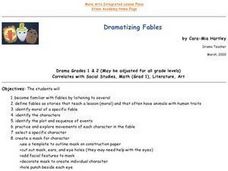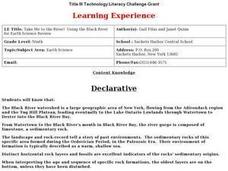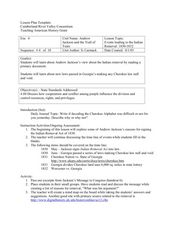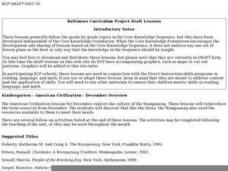Curated OER
How Worldly Are You?
Sixth graders locate and map six components to have a working knowledge of maps. In this map skills lesson, 6th graders define the six map components and work in groups to draw a map using the components. Students read a related...
Curated OER
Rooster's Night Out
First graders complete interdisciplinary activities associated with a folktale from Cuba. For this Cuban folktale lesson, 1st graders read the Rooster's Night Out, before completing comprehension worksheets, make recipes, and...
Curated OER
A Birthday Basket for Tia
Students practice reading and math skills using technology. In this main idea lesson, students retell the important events of A Birthday for Tia in sequence using Kid Pix. Students create a bar graph using The Graph Club...
Curated OER
GREEK MYTH IN PAINTING
Second graders look closely at a Renaissance painting depicting an ancient Greek myth, review the term renaissance, hear a Greek myth that tells how the peacock got its tail, sequence the story, and identify the actions of the myth in...
Curated OER
Dramatizing Fables
Students familiarize themselves with fables by listening to several of them. They define fables. They identify the moral of a specific fable. They identify characters, plot and sequence of events. They create a mask of a character in a...
Curated OER
Where Am I?
Second graders listen to a Japanese folk tale called "The Traveling Frogs". They role play the story using puppets or costumes. They locate Japan on a map and discuss several geography topics. They independently write about ways they...
Curated OER
Caribbean Islands
Second graders discover the characteristics of the Caribbean Islands. After being read a story, they use maps to locate the locations mentioned. They recall the sequence of events in the story and identify the cultural traits and...
Curated OER
Cause and Effect
Young scholars identify cause and effect relationships in a short story. After reading a short story, they participate in a discussion of how one event in a story can lead to several others. Students are then paired for a matching task...
Curated OER
Take Me to the River! Using the Black River for Earth Science Review
Ninth graders use maps to identify landscape regions and drainage patterns producing the Black River. They create PowerPoint presentations pertaining to the Black River watershed, its geologic history and highlighting safe rafting...
Curated OER
Inferring Themes
Fifth graders practice making inferences on various types of reading material. As a class, they develop a definition of the word "theme" and discuss themes for some of their favorite stories. They use the context of the reading...
Curated OER
Settling the Plymouth Colony
Students label blank maps with the names of the New England Colonies. They explain the difficulties that the Pilgrims had and how hard they worked to survive in Plymouth.
Curated OER
Create Your Island Paradise
Sixth graders create a descriptive essay and map describing their island paradise. They try to evoke the reader's senses: seeing, hearing, touching, smelling, and tasting. They revise their paragraphs using their partner's feedback.
Curated OER
Phonics lesson for -ar
First graders identify words associated with the -ar sound. They read sentences and compose a story that include words with the -ar sound. The assessment portion of lesson involves students in spelling words with the
-ar pattern.
Curated OER
Phonics lesson for "sh"
First graders identify words with the "sh" pattern. They participate in phonemic awareness, decoding, blending, spelling patterns, and dictation exercises. As the assessment portion of the lesson, they may write a story using words...
Curated OER
Directing Me
First graders practice the language of directions and positions in this unit. They follow sequences in which they rotate their bodies and other objects through quarter and half turns while participating in games.
Curated OER
Language Arts: Native Americans and Onomatopoeias
Fifth graders read the Native American tale, "The Frog and the Crane," focusing on the use of onomatopoeia in it. In groups, they brainstorm list of words that are examples of the device. Finally, 5th graders write their own stories...
Curated OER
Down on the Ocean Floor
Young scholars build a map of the Atlantic Ocean floor and mark the different depths. In this ocean floor lesson students identify parts of the ocean floor that they created and discuss patterns that they see.
Curated OER
Catch Me If You Can: Over and Under
Students read a story. In this vocabulary skills lesson plan, students read The Gingerbread Man, use flannel cut outs to re-enact the gingerbread man running over and under.
Curated OER
Events Leading to the Indian Removal 1830-1832
Learners consider the effects of Indian Removal on the Cherokee Nation. In this American history activity, students research Internet and print sources regarding the Indian Removal Act of 1830. Learners write short stories that detail...
Curated OER
Through Time: Change in Sedona
Students locate events on a timeline of Sedona, Arizona and describe human and physical characteristics of the city. In this Sedona lesson plan, students locate the city on a map and listen to stories about Sedona.
Curated OER
Following a Monster
Students follow tracks of a monster who has walked through their classroom to see what he has done. They discuss sequencing vocabulary before using computer software students sequence the monster's visit using a concept map. In a word...
Curated OER
Fairy Tales: Thumbelina, Jack and the Beanstalk and Issun Boshi
First graders read several selections of poems and stories. They focus on a selection of fairy tales including Jack and The Beanstalk, Thumbelina and Issun Boshi. They complete several comprehension activities and compare the different...
Curated OER
Literature Overview of African Folktales
Students play a game of tug-of-war, participate in a discussion about the story, discuss the phrase "bigger doesn't mean better." , and illustrate a scene from the story.
Curated OER
Wampanoag Indians
Students read stories and listen to a brief lecture about the Wampanoag Indians, aspects of their culture and their role in the first Thanksgiving. They make a Wampanoag carrying pouch out of a paper bag and cook a corn cake as a class.























